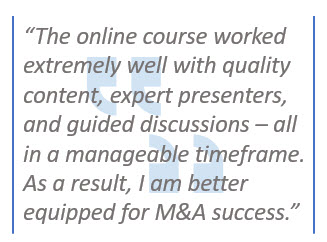Differences Between the Art of M&A Integration and Program Management
By Mark Herndon, Chairman of the M&A Leadership Council

I received a great question via email the other day that’s worth sharing. “Several of our M&A team members have been to the M&A Leadership Council’s in-person workshop, The Art of M&A Integration. What is different in the new online workshop The Art of M&A Program Management that would be worth our time?”
My answer? Think of them as salt and pepper – totally different, but you want both on a delicious steak!

Before jumping into the specific differences between the two, let me tell you what’s the same. Both workshops are facilitated by real M&A experts and deeply experienced corporate practitioners that will give you the practical, applicable “practitioner’s viewpoint” that you can take back and apply in your organization. Both workshops are instructed in a highly interactive, experiential learning format that balances the content delivery with insightful open discussion and group exercises. Both workshops culminate in a capstone case study exercise of an actual (and recognizable) prior deal. You will be asked to work in a small group, answer specific questions that apply the concepts in the course, and read-out your recommendations for other workshop participants. Finally, both workshops – even our online workshops get outstanding feedback from participants with an average rating of 4.5 on a scale of 5.0 and comments like this actual participant quote seen to the right.
Now let’s review the differences:
The Structure
The Art of M&A Integration (“Integration”) was our first workshop that helped launch the M&A Leadership Council over ten years ago. Through continued value-engineering and non-stop innovation, it is still one of our most popular and highly rated workshops. Integration is built on a topical overview structure and provides a solid grounding in best practices, failure factors, and success principles across a wide range of subjects including, but not limited to:
- The ROI of effective integration. Specific integration best practices and their impact on business result outcomes such as revenue synergy capture, cost synergy capture, the overall pace of integration, and avoidance of “value erosion” or unintended negative business impacts of integration.
- Deal strategy implications for integration. Given each deal’s principal investment thesis, what type of integration or overall approach to integration should you take, and what does each “deal-type DNA” look like?
- Defining the “concept of operations” as an input to the overall integration strategy. This is still one of the best decision support tools I have encountered in my career to help executive teams set the broad directional approach for enterprise integration and essential functional, go-to-market, and programmatic guardrails before the formal launch of detailed integration planning.
- Essential functional insights and best practices for IT integration, people and organizational risks, communications and change management, and cultural integration. Each presented by a deep functional SME with actual war stories, lessons learned, and up-to-date insights to help your organization get better results.
The Art of M&A Program Management (“Program Management”) initially launched five years ago and has also undergone continuous value-engineering and non-stop innovation. Frankly, we get the most outstanding feedback on this workshop. First, a caution is in order - Despite the title (admittedly a misnomer) this workshop is not about the basic blocking and tackling project management skills such as initiating, planning, executing, controlling, and closing a project. Nope – that’s not it. There are plenty of excellent basic project management courses out there where you can learn the core Project Management Body of Knowledge (“PMBOK”). Instead, this workshop identifies and discusses 20 specific decisions, events, and processes across the entire M&A lifecycle that every Integration Leader, IMO, and Program Manager absolutely, positively must plan and execute effectively to be successful! It is entirely different by design, in that it focuses on the roles of the Integration Leader, the Integration Management Office (“IMO”) and the Integration Program Manager.
On a phase-by-phase basis across the M&A lifecycle, this workshop will help you identify best practices, applicable insights and lessons learned including:
- Phase 1 – Strategy & Targeting. In this phase, we will cover integration resourcing, readiness, and costs of integration. Does your executive team and corporate development team know that staffing and budget implications of different deal types and sizes? Without planning these essential inputs into the financial model from the outset, many deals never have a chance to hit their desired business results.
- Phase 2 – Due Diligence and Transaction Management. This phase covers the increasingly important role of the Diligence Management Office (“DMO”). How the Integration Leader and IMO should be “read-into” the deal. How to effectively transition from diligence to integration to capture the insights, nuance, risks, action items, and decisions needed before the launch of detailed integration planning.
- Phase 3 – Integration Pre-Announce. This phase covers the integration strategy framework – what it is, who, when, and how it is developed and why it matters to the results of the deal. Also, you will learn critical insights for launching the IMO, program governance, and the IMO’s role in planning, messaging and executing the all-important initial deal announcement.
- Phase 4 – Integration Pre-Close. Now it’s time to deep dive into core integration best practices and processes such as pre-close legal do’s and don’ts – what you can and can’t plan with your counterpart before closing; defining and executing a genuinely successful Day 1 – including cutovers, messaging, change management, employee and customer experience that will help you make your dull, ineffective “cupcakes and townhalls” approach to Day 1 to an actual, world-class business and change management breakthrough, especially in our challenging virtual environment.
- Phase 5 – Integration Post-Close. As an Integration Leader, IMO, or Program Manager, this should be your “bread-and-butter.” We have found that most organizations fall far short of what they can and should be doing with critical processes. For example, Integration Discovery; Launch of Joint Integration Planning; Developing the Integration Plan of Record and Cross-functional Dependencies; executing and tracking the deals essential “value-drivers; and of course, cadence, statusing, reporting and dealing with “RAID” (e.g., risks, action items, issues and decisions needed) throughout the execution phase.
- Phase 6 – Long-term Value Capture. Truth in advertising notice – given time constraints, we’ll only have time for a brief overview of this phase. Frankly, many organizations fail at this all-important step, and we believe this is a key reason so many deals STILL underperform the anticipated business results. The good news? Through interactive discussion combined with expert viewpoints, your organization will gain essential insights on “when is integration over;” the importance of conducting a comprehensive program assessment and “transfer of operations,” then relaunching a new phase of integration.
As you can see, these workshops are individually important and robust. Each brings their own unique flavor to your M&A success. I hope that we've whetted your appetite and that we'll welcome you to our table soon!
Please contact us with any questions you have about these workshops. In the meantime, we hope to see you soon at an upcoming online training!